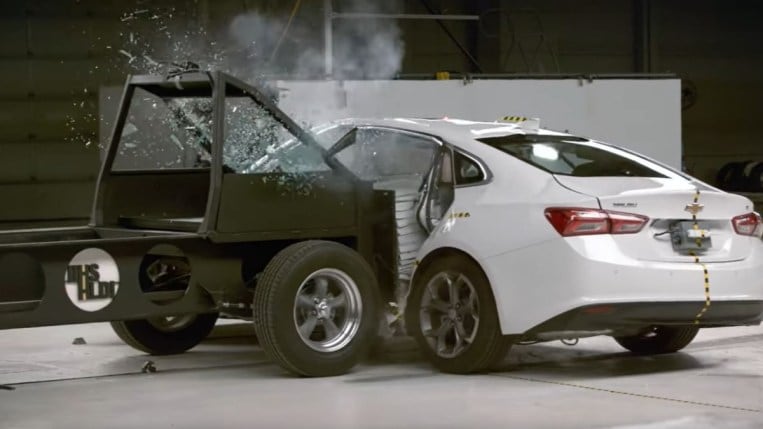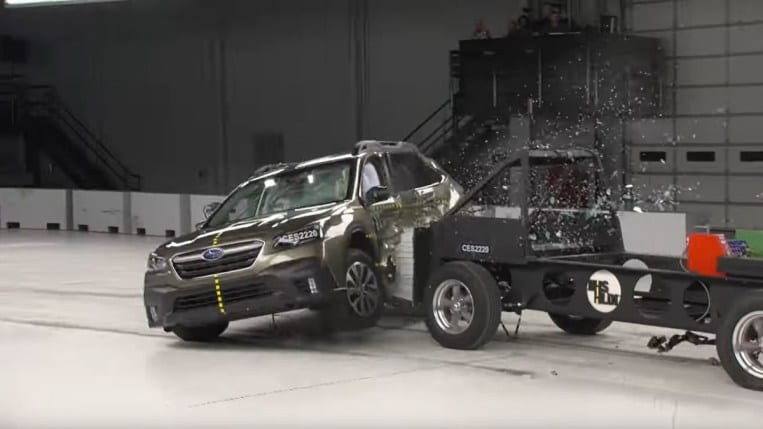Quick Facts About Vehicle Safety Ratings
- Two nonprofit authorities rate vehicles for safety: the IIHS and NHTSA.
- NHTSA uses a 5-star scoring system, while the IIHS uses Good, Acceptable, Marginal, and Poor.
- Crash testing is a critical component of vehicle safety ratings.
Although safety ratings may not be the first concern for some car buyers, it’s often the top consideration when shopping for a family vehicle. The way a car performs in a wreck is serious business and can mean everything to your family in surviving a crash. Carmakers have made great strides in engineering safety into today’s new cars. However, third-party nonprofit watchdogs, like the federal government and the Insurance Institute for Highway Safety (IIHS), continually redefine what is safe through evolving crash tests.
To get a handle on which cars, trucks, and SUVs are the safest, you must not only discover a vehicle’s test scores but also understand them. Every year, millions of dollars are invested in crash testing and other safety tests, rating the dependability of different vehicle models in crashes. Some tests are as basic as running a vehicle into a concrete wall, while others require meticulous measurements, attention to detail, and scientific disciplines.
As you read on, we will explain in more detail who awards crash-test and safety ratings, precisely what they test, and what the scores mean.
What Are Car Safety Ratings?

Safety ratings are the scores the IIHS and the United States government, through its National Highway Traffic Safety Administration (NHTSA), give to vehicles. They award the scores after putting cars through a battery of crash and safety tests. You may be more familiar with the government’s tests. The scores appear on every new car’s Monroney label (window price sticker). Therefore, you might have seen the scores on the labels expressed as stars.
What Are NHTSA Safety Ratings?
NHTSA administers and scores three crash tests and a Rollover Resistance Test. Depending on how a vehicle performs, NHTSA awards from one star (least safe) to five stars (most safe) for each test and an overall score. For obvious reasons, it’s called the 5-Star Safety Ratings Program.
What Are the NHTSA Crash Tests?
- Frontal Crash Test – To test structural integrity and the likelihood and nature of passenger injury in a head-on collision, the vehicle is crashed into a fixed barrier at 35 miles per hour. A larger adult dummy is arranged in the driver’s seat, with a smaller adult dummy in the passenger seat. Injury evaluations include the head, neck, chest, and legs.
- Side Barrier Crash Test – This test is engineered to simulate another car T-boning the test car on the driver’s side in an intersection. A 3,015-pound moving barrier rams into the stationary test vehicle’s driver’s side at 38.5 mph. The test evaluates a larger adult dummy in the driver’s seat and a smaller adult dummy in the seat behind the driver for head, chest, abdomen, and pelvis injuries.
- Side Pole Crash Test – This test simulates a vehicle skidding sideways into a telephone pole. At a 75-degree angle, the testers pull the subject vehicle sideways into roughly a 10-inch-diameter pole at 20 mph. The impact occurs at the driver’s seating position. A small adult dummy in the driver’s seat is evaluated for head, chest, lower spine, abdomen, and pelvis injuries.
- Rollover Resistance Test – Not a crash test at all; this scenario uses a measurement known as the Static Stability Factor to determine how top-heavy a vehicle is. Or, in other words, how likely it is to tip over during a severe driving maneuver.
What Are the IIHS Safety Ratings?

The IIHS performs several crash tests on vehicles. However, for the most part, they are different from those of NHTSA. Think of them as complementary to the NHTSA tests. Moreover, the IIHS rates safety-related features like forward collision warning systems, headlight effectiveness, and more. We won’t trek too far into the weeds on the supplemental testing; however, it does come into play for the IIHS Top Safety Pick (TSP) and Top Safety Pick+ (TSP+) awards. More about those later.
Rather than the U.S. government’s 5-Star Safety Ratings Program, the IIHS separates the results into Good, Acceptable, Marginal, and Poor scores. The IIHS awards a score for each test but not a combined overall score. They also score different specifics within the test. For example, in the Small Overlap Front: driver-side, the IIHS also scores the safety cage and each driver injury measure.
One more note: The IIHS is in an evolutionary period. Some tests are changing, and others are going away. The criteria for determining the TSP and TSP+ lists are evolving as well.
What Are the IIHS Crash Tests?
Small Overlap Front: driver-side – Measuring the results of a crash on the front left corner of the test vehicle, it runs into a barrier (representing a tree or power pole) at 40 mph. An adult-size dummy in the driver’s seat is evaluated for head, neck, chest, hip, thigh, lower leg, and foot injuries.
Small Overlap Front: passenger-side – Like the driver-side test, this crash measures the effects of a crash on the right front corner. However, this test evaluates the injuries on dummies in the driver and passenger seats.
Moderate Overlap Front: original test – As the original IIHS frontal crash test, it represents the results of an offset frontal crash between two vehicles. Engineers crash a car traveling 40 mph into a barrier with a deformable aluminum honeycomb face. In this scenario, 40% of the vehicle face strikes the barrier. An adult-size dummy sits in the driver’s seat, with a smaller dummy representing a 12-year-old child in the seat directly behind the driver. The injury evaluation involves both dummies.
Side: original test – On its way to being replaced by the IIHS’ Side updated test, the original test employs a rolling 3,300-pound barrier with a honeycombed face located at the height of the average SUV. It rams the driver’s side of the test vehicle at the side doors at a speed of 31 mph. The test evaluates an adult-size dummy in the driver’s seat and a 12-year-old child-size dummy in the seat behind for injuries. Those injuries are head, neck, torso, pelvis, and leg.
Side: updated test – The IIHS has slated this updated test will eventually be its side-test standard. Using a heavier (4,200 pounds) but lower ram, engineers crash it into the driver’s side of the test vehicle at 37 mph. Similar to the original test, the updated test uses two dummies in the front and rear driver’s side seating positions to evaluate head, neck, torso, and pelvis injuries.
Other IIHS Evaluations
The IIHS evaluates several other vehicle components and systems in determining overall safety. For 2023, the IIHS eliminated ratings for roof strength, head restraints, and vehicle-to-vehicle front-collision avoidance.
In the area of front-crash protection, the IIHS scores vehicles for how well the frontal-crash-avoidance systems perform. Here are two tests for each category: 12 mph and 25 mph. Scoring here is Superior, Advanced, and Basic.
What IIHS Scores With Other Tests
- Vehicle to pedestrian: The IIHS uses three unique scenarios to rate a vehicle’s ability to avoid striking a pedestrian. In the first scenario, an adult dummy crosses in front of the vehicle. In the second test scenario, a child dummy comes between parked cars and crosses in front of the vehicle. For the third, an adult dummy walks with traffic along the right side of the road.
- Vehicle to pedestrian night: This evaluation rates the vehicle’s pedestrian avoidance capabilities at night. It repeats the two tests using the adult dummy.
The IIHS also performs a headlight evaluation. Using a scoring system of Good, Acceptable, Marginal, and Poor, they test headlight intensity and reach in different scenarios.
Also, using the Good-to-Poor scores, the IIHS evaluates seatbelt reminder alerts for front- and rear-seat positions. Sound level, pitch, and duration are some of the measured functions.
Finally, the IIHS evaluates the LATCH (Lower Anchors and Tethers for Children) child-seat-tether systems in vehicles. Location, accessibility of lower anchors, ease of use, and more enter into the evaluation.
RELATED: Best Vehicles to Comfortably Fit Three Car Seats Across
What Are Top Safety Pick and Top Safety Pick+?
In 2006, the IIHS introduced its Top Safety Pick award, followed by its Top Safety Pick+ in 2013. Vehicles appearing on these two annual lists are the IIHS picks as the top safety performers. To be named to either list for 2023, a car must have the following:
- Good ratings in the driver-side small overlap front, passenger-side small overlap front, original moderate overlap front, original side, updated side, roof strength, and head restraints.
- Superior or Advanced ratings in the frontal crash avoidance evaluations for daytime vehicle-to-pedestrian scenarios.
- Good or Acceptable headlight ratings.
Moreover, to earn the TSP+ rating, a vehicle must also receive a score of Superior or Advanced for the nighttime vehicle-to-pedestrian collision avoidance evaluations. Additionally, the Good or Acceptable headlight ratings must be for the standard equipment lights on all trim levels. (To qualify for TSP, Good or Acceptable headlights must be available as an option.)
Where to Find Safety Ratings?
If you shop for a new or used car, you can find the NHTSA’s ratings on the Monroney label, or window sticker. Otherwise, check out NHTSA and IIHS websites for ratings.
What Other Safety Features Should You Look For?
When shopping for cars with a high degree of safety, our advice is to buy all of the advanced safety technology you can afford. You can find a lot of it available, including high-beam assist, lane-keeping assist, adaptive cruise control, front-rear park assist, blind-spot monitoring, rear cross-traffic alert, and more.
NHTSA Recommendations
How to Decide on the Right Car for You
Let’s face it; your budget will have much to do with the car you pick. Consequently, you need to maximize every dollar you spend. Achieving that goal requires some soul-searching on your part. Before you begin fantasizing about the secondary features like sound system, leather seating, and so forth, you must meet your needs. Needs should always trump wants, especially if you are on a budget.
What to Consider Before Buying a Vehicle
- Exactly what type of vehicle do you need? In other words, do you need a compact sedan, a minivan, a pickup truck, an SUV, or something else entirely?
- What is your budget, which is asking how much vehicle can you afford?
- How safe do you need it to be in relation to how you will use the vehicle? That is, will it be the primary transportation for your family? The safety feature consideration will probably be different if it’s a family car instead of a sports car for your weekend entertainment.
- If safety technology tops your must-have features list, find a model with a wide array of safety technology included in the base price. There are plenty of such vehicles out there for 2023. For example, the Kia Forte LX, Nissan Rogue S, the Chevy Blazer 2LT, the Honda Civic Sport, the Hyundai Palisade SE, and so forth all have a bundle of safety tech.
What to Keep in Mind
No matter a vehicle’s safety rating or the volume of advanced safety features, the key safety component is the driver. Some safety tech can help prevent crashes, and some can lessen crash severity, but the most effective influence on safety is avoiding dangerous situations altogether.


